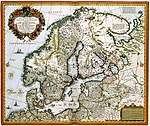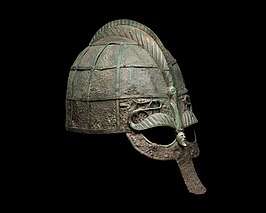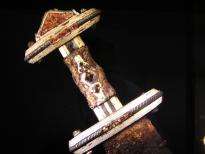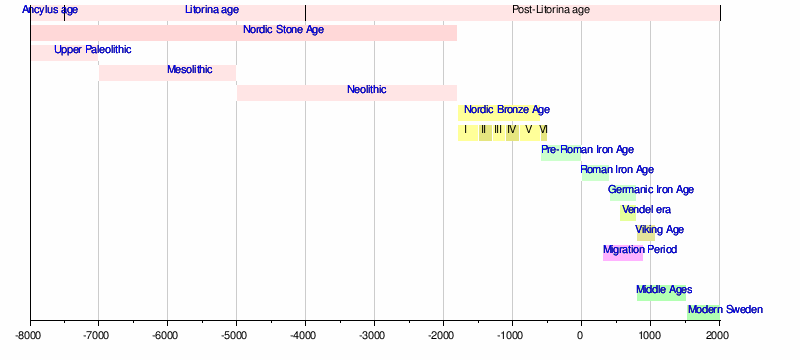Vendel Period
In Swedish prehistory, the Vendel Period (550–790) comes between the Migration Period and the Viking Age. The migrations and upheaval in Central Europe had lessened somewhat, and two power regions had appeared in Europe: the Merovingian kingdom and the Slavic princedoms in Eastern Europe and the Balkans. A third power, the Catholic Church, had begun to expand its influence.
Part of a series on the |
|---|
| History of Sweden |
 |
|
Prehistoric
|
|
Consolidation
|
|
Great Power
|
|
Enlightenment
|
|
Liberalization
|
|
Modern
|
| Timeline |
|
|


In Scandinavia, the Germanic clan society was still very much alive. In Uppland, in what today is the east-central part of Sweden, Old Uppsala was probably the centre of religious and political life. It had both a well-known sacred grove and great Royal Mounds. There were lively contacts with Central Europe, and the Scandinavians continued to export iron, fur, and slaves; in return they acquired art and innovations, such as the stirrup.
Finds from well-preserved boat inhumation graves at Vendel and Valsgärde show that Uppland was an important and powerful area consistent with the account of the Norse sagas of a Swedish kingdom. Some of the riches were probably acquired through the control of mining districts and the production of iron. The rulers had troops of mounted elite warriors with costly armour. Graves of mounted warriors have been found with stirrups and saddle ornaments of birds of prey in gilded bronze with encrusted garnets.
These mounted elite warriors are mentioned in the work of the 6th century Goth scholar Jordanes, who wrote that the Swedes had the best horses beside the Thuringians. They also echo much later in the sagas, where king Adils is always described as fighting on horseback (both against Áli and Hrólf Kraki). Snorri Sturluson wrote that Adils had the best horses of his days.
Swedish expeditions began to explore the waterways of what was to become Russia, Ukraine, Belarus at this time.
Games were popular, as is shown in finds of tafl games, including pawns and dice.
Timeline of Swedish history

References
| Wikimedia Commons has media related to Vendel era. |
- Jesch, Judith (ed.) (2012). The Scandinavians from the Vendel Period to the Tenth Century: An Ethnographic Perspective, Boydell Press, 2012. ISBN 9781843837282
- Hyenstrand Å. Lejonet, draken och korset. Sverige 500–1000. Lund, 2001. S.